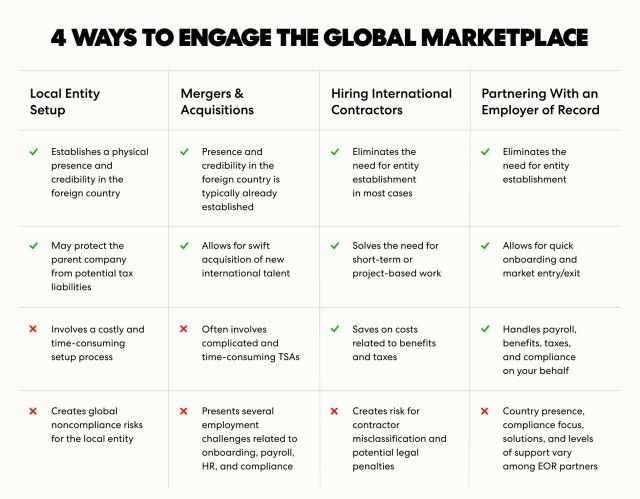International companies reap a wide range of benefits by expanding globally, such as accessing new revenue streams and a broader talent pool. However, conducting business across borders has several logistical challenges and compliance risks.
Companies must administer global payroll, benefits, and ongoing HR support for their distributed workforce while complying with employment and tax laws across multiple regions.
Read this guide to learn what the global marketplace is, the associated benefits and challenges, and the four main methods businesses use to enter new markets. Plus, find out how to simplify global expansion and eliminate compliance risks along the way.
What is the global marketplace?
The global marketplace refers to the exchange of goods, services, and labor across global markets, unencumbered by international borders.
For some companies, the global marketplace refers to the majority of markets worldwide. For example, tech giant Apple offers services in 175+ countries. However, smaller companies, such as regional airlines, offer services only in select regions of the global marketplace.
By expanding globally, a business enjoys a range of benefits it wouldn’t otherwise have access to domestically.
Read more: How to Gain a Competitive Edge in a Global Marketplace
Benefits of engaging the global marketplace
The most widely known benefits of participating in the global marketplace are expanded market share and increased profits. However, global expansion also helps companies thrive during economic uncertainty, diversify their workforce, harness innovative solutions, and reduce business costs.
We discuss each of these in detail below.
Improve stability amid economic uncertainty
Doing business in multiple countries allows for market diversification, which reduces risk during economic uncertainty. Should one market experience an economic downturn, success in other markets can offset losses.
For example, in a Chief Executive study, nearly one in five global companies acquired enough growth from international operations over four years to offset negative growth in their domestic markets.
Access a broader talent pool
International expansion allows employers to access the global talent pool and engage candidates with various skill sets, backgrounds, and salary expectations. With access to global talent, companies can offset skills and labor shortages domestically, enjoy more room for salary negotiations, and tailor their workforce to the organization’s unique needs.
A broader talent pool also means global companies can develop a more diverse and inclusive workforce. According to Glassdoor, 76% of job seekers prefer working for diverse companies.
Harness new innovative solutions
Technology, innovation, and cultures vary worldwide, and entering the global marketplace provides access to new technology and norms. Organizations can increase their global fluency and adapt new technologies and equipment processes for competitive innovation and cost-cutting strategies domestically and abroad.
Reduce costs of doing business
The global marketplace offers cost savings relative to a company’s domestic market. For example, living costs and wages may be lower abroad than in your home country, which reduces overall staffing expenses.
Global companies also gain access to cheaper raw materials, superior technological processes, and favorable tax incentives—all of which reduce long-term operating costs.
Challenges of engaging the global marketplace
Despite the benefits of global expansion, doing business across borders comes with a unique set of challenges.
International tax liabilities
Global companies must comply with the local tax laws of each country in which they do business. For example, you must familiarize yourself with corporate tax and Value-Added Tax (VAT) laws across multiple jurisdictions.
While the legislation varies between countries, your local tax liability largely depends on whether or not you have created a permanent establishment (PE) in the host country. Even sending remote employees abroad for short-term assignments, such as contract negotiation, can indicate PE and trigger a local corporate tax liability.
Overlooking tax liabilities leads to fines, back pay, and limited business opportunities.
Compliance with international labor laws
Employment law also poses a significant compliance risk for global employers. International organizations must establish employment contracts that comply with region-specific minimum wage requirements, leave entitlements, worker classification laws, and relevant collective bargaining agreements (CBAs).
For example, CBAs in Italy regulate issues beyond local labor law parameters, including holidays, leave, overtime, and information rights. Inadvertently overlooking and failing to comply with relevant CBA mandates results in hefty fines.
Learn more: How to Stay Compliant When Hiring Internationally
Limited scaling and technology infrastructure
Global companies need a variety of tools and technologies to effectively scale HR and legal operations across multiple countries and time zones.
Foreign employers must run timely and compliant global payroll, comply with immigration requirements, and administer locally tailored benefits for teams across multiple jurisdictions.
Sourcing the needed tools and infrastructure to run such vital processes compliantly is often challenging for smaller companies with limited resources and scaling abilities.
Options for engaging the global marketplace
Below we outline four international business strategies that organizations can pursue to facilitate expansion into the global marketplace.

Set up local entities
Many global companies create a separate legal entity in the target country, such as a representative office, branch office, or foreign subsidiary. Entity establishment makes sense primarily for companies that are ready to make long-term investments in the target country.
Pros: Some legal entities shield the parent organization from tax liabilities in the host country. They also help establish credibility with local authorities and build trust among local consumers.
Cons: Entity establishment is a lengthy and costly process that involves long-term investments in the target country and poses significant compliance risks.
Learn more: The Hidden Costs of Entity Establishment
Acquire or merge with foreign businesses
Some companies choose to negotiate with an existing organization in the target country to purchase it directly or combine the two companies into one legal entity. While this is similar to entity establishment, acquisitions and mergers have unique advantages and disadvantages.
Pros: An existing foreign business already has a local market share, customer base, and financing relationships and is fully integrated and compliant with local labor and tax laws.
Cons: Handling country-specific compliance regulations, transitional service agreements, and employee onboarding during the transaction period is time-consuming, entails legal and financial risks, and often increases employee churn.
Hire international contractors
Companies interested in short-term international projects may choose to engage contractors instead of hiring employees, which offers valuable flexibility.
Pros: Hiring contractors involves lower levels of commitment, simplified onboarding and termination, and no additional costs, such as payroll taxes and statutory benefits.
Cons: Hiring contractors may dilute service quality, erode business reputation, and present serious misclassification risks that could result in employee back pay and fines.
Use an employer of record
An employer of record (EOR) is a third-party organization that offers global companies support throughout the entire lifecycle of international expansion, from hiring and onboarding to running global payroll and providing ongoing HR support.
Pros: Partnering with an EOR simplifies global expansion by eliminating the need for entity establishment, allows for swift market entry and exit, guarantees compliance, and relieves your HR team by streamlining all processes into a single platform.
Cons: Finding a vetted and reliable EOR that offers a full range of solutions in your target markets and puts critical focus toward compliance requires time-consuming due diligence.
Learn more: What Is an Employer of Record (EOR)?
Achieve Your global business goals with the right partner
Working with an experienced and trustworthy partner is vital for ensuring compliance and speed-to-market as you enter the global marketplace. Overcome borders and shed the burden of global expansion by partnering with Velocity Global.
Velocity Global’s EOR solution eliminates compliance risks and streamlines global expansion in more than 185 countries. As the legal employer of your international workforce, we eliminate the need for entity establishment so you can quickly and cost-effectively enter new markets and hire top-tier talent—no matter their location.
Our team of experts handles hiring, onboarding, immigration, global payroll, benefits, and ongoing HR support on your behalf so that you can expand globally without added stress.
Contact Velocity Global today to learn how to simplify global expansion and hiring.
Disclaimer: The intent of this document is solely to provide general and preliminary information for private use. Do not rely on it as an alternative to legal, financial, taxation, or accountancy advice from an appropriately qualified professional. © 2023 Velocity Global, LLC. All rights reserved.



